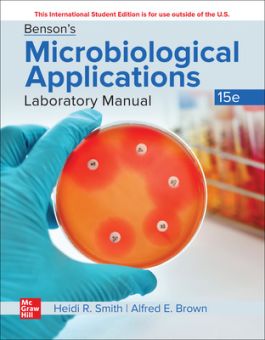Benson's Microbiological Applications Laboratory Manual--ConcVersion ISE
2 Darkfield Microscopy
3 Phase-Contrast Microscopy
4 Microscopic Measurements
Part 2 Survey of Microorganisms
5 Microbiology of Pond Water - Protists, Algae, and Cyanobacteria
6 Ubiquity of Bacteria
7 The Fungi: Molds and Yeasts
Part 3 Manipulation of Microorganisms
8 Aseptic Technique
9 Pure Culture Techniques
Part 4 Staining and Observations of Microorganisms
10 Smear Preparation
11 Simple Staining (Observing Bacterial Cell Morphology)
12 Negative Staining
13 Capsular Staining
14 Gram Staining
15 Endosphere Staining
16 Acid-Fast Staining: Kinyoun Method
17 Motility Determination
Part 5 Culture Methods
18 Culture Media Preparation
19 Enumeration of Bacteria: The Standard Plate Count
20 Slide Culture: Fungi
Part 6 Bacterial Viruses
21 Determination of a Bacteriophage Titer
22 Isolation of Phage from Flies
23 Phage Typing
Part 7 Environmental Influences and Control of Microbial Growth
24 Effects of Oxygen on Growth
25 Temperature: Effects on Growth
26 pH and Microbial Growth
27 Water Activity and Osmotic Pressure
28 Ultraviolet Light: Lethal Effects
29 The Effects of Lysozyme on Bacterial Cells
30 Evaluation of Alcohol: Its Effectiveness as an Antiseptic
31 Antimicrobic Sensitivity Testing: The Kirby-Bauer Method
32 Evaluation of Antiseptics: The Filter Paper Disk Method
33 Effectiveness of Hand Scrubbing
Part 8 Identification of Unknown Bacteria
34 Morphological Study of An Unknown Bacterium
35 Cultural Characteristics
36 Physiological Characteristics: Oxidation and Fermentation Tests
37 Physiological Characteristics: Hydrolytic and Degradative Reactions
38 Physiological Characteristics: Multiple Test Media
39 Use of Bergey’s Manual
Part 9 Miniaturized Multitest Systems
40 Enterobacteriaceae Identification: The API 20E® System
41 Enterobacteriaceae Identification: The Entero-Pluri- Test System
42 Staphylococcus Identification: The API® Staph Test System
Part 10 Applied Microbiology
43 Bacterial Counts of Foods
44 Bacteriological Examination of Water: Most Probable Number Determination
45 Bacteriological Examination of Water: The Membrane Filter Method
46 Reductase Test
47 Temperature: Lethal Effects
48 Microbial Spoilage of Canned Food
49 Microbiology of Alcohol Fermentation
Part 11 Bacterial Genetics and Biotechnology
50 Polymerase Chain Reaction for Amplifying DNA
51 Bacterial Transformation
52 CRISPR-Cas9 System
Part 12 Immunology and Serology
53 The Staphylococci: Isolation and Identification
54 The Streptococci and Enterococci: Isolation and Identification
55 Gram-Negative Intestinal Pathogens
56 A Synthetic Epidemic
Part 13 Immunology and Serology
57 Slide Agglutination Test: Serological Typing
58 Slide Agglutination Test for S. aureus
59 Slide Agglutination Test for Streptococcus
60 Enzyme-Linked Immunosorbent Assay (ELISA)
61 Blood Grouping
McGraw-Hill Connect is an award-winning digital teaching and learning solution that empowers students to achieve better outcomes and enables instructors to improve course management efficiency.
High-Quality Course Material
Our trusted solutions are designed to help students actively engage in course content and develop critical higher-level thinking skills while offering you the flexibility to tailor your course to the ways you teach and the ways your students learn.
Assignments & Automatic Grading
Connect features a question bank that you can select from to create homework, practice tests and quizzes. Dramatically reduce the amount of time you spend reviewing homework and grading quizzes, freeing up your valuable time to spend on teaching.
Analytics & Reporting
Monitor progress and improve focus with Connect’s visual and actionable dashboards. Reports are available to empower both instructors and students with real-time performance analytics.
Seamless Integration
Link your Learning Management with Connect for single sign-on and gradebook synchronization, with all-in-one ease for you and your students.


